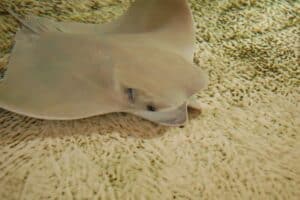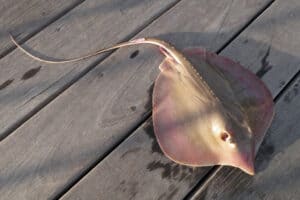Wonderous and wildly misunderstood; there’s no other way to describe rays… or is it skates? Is there a difference? Wait, what even is a skate? Contrary to popular belief, skates and rays are two entirely different fish, though both can be found in Maryland’s Coastal Bays!
Main Differences

At first glance, it can be pretty difficult to spot the physical differences between a skate and a ray; however, there are numerous physical distinctions which set the two apart. The most obvious of these differences lie within their tails. Cownose rays have venomous spines at the base of their tails which are typically described as slender and whiplike. Skates lack any sort of venomous spines on their shorter stockier tails.
Also, skates tend to have a highly pronounced dorsal fin (the fin on top of their bodies), while rays do not. Due to their lack of stinging spines, the sharp protrusions along skate’s backs offer them added protection. Rays tend to be larger than skates; they can have a wingspan of up to three feet and weigh as much as fifty pounds! Skates and rays can also be similar in coloration, usually appearing to be brown or murky green with an off-white underside.

Reproduction
Perhaps one of the greatest differences between skates and rays are the differences in their reproductive habits. While both skates and rays both display high site fidelity by returning to spawn at the same nursery ground each year, their methods of reproducing differ greatly. Rays reproduce especially slowly. They mate between June and July each year, and after an 11-month period of gestation, females give birth to a single live offspring called a “pup”. Pups can measure anywhere between 11 and 18 inches.
After spawning, males make their exit, while females stay in our waters until October. This slow reproductive cycle means ray populations are fragile and take a long time to grow. Skates on the other hand, reproduce by laying eggs in a protective egg case commonly referred to as a “mermaid’s purse.”
Once this protective covering forms around the skate embryo, it is unloaded from the mother on to the sea floor where it remains for almost 15 months before hatching.
Similarities
While the differences between skates and rays are plentiful, they also have a lot in common! Stingrays and skates are both considered to be elasmobranchs, which means that they are cartilaginous fish with skeletons made of cartilage, not bone.

Skates and rays are actually closely related to sharks which are also elasmobranchs. Skates also share similar feeding habits with rays; both creatures can be found preying on small shellfish like crabs and clams found within our Coastal Bays!
So, the next time you find yourself out enjoying our bays and see one of these entrancing elasmobranchs, pause and ask yourself: “Wait, is it a ray or a skate?”
About the Author
Maddie Talnagi is currently serving as the MCBP‘s Chesapeake Conservation Corps member. Maddie is a recent graduate of The College of William & Mary where she studied psychology and history. At MCBP, Maddie assists with wetland assessments, restoration monitoring, the Oyster Gardening Program, and water quality monitoring efforts. Maddie is passionate about coastal resilience and mitigating the effects of climate change and hopes to continue her education by pursuing a master’s degree in conservation and environmental management.

